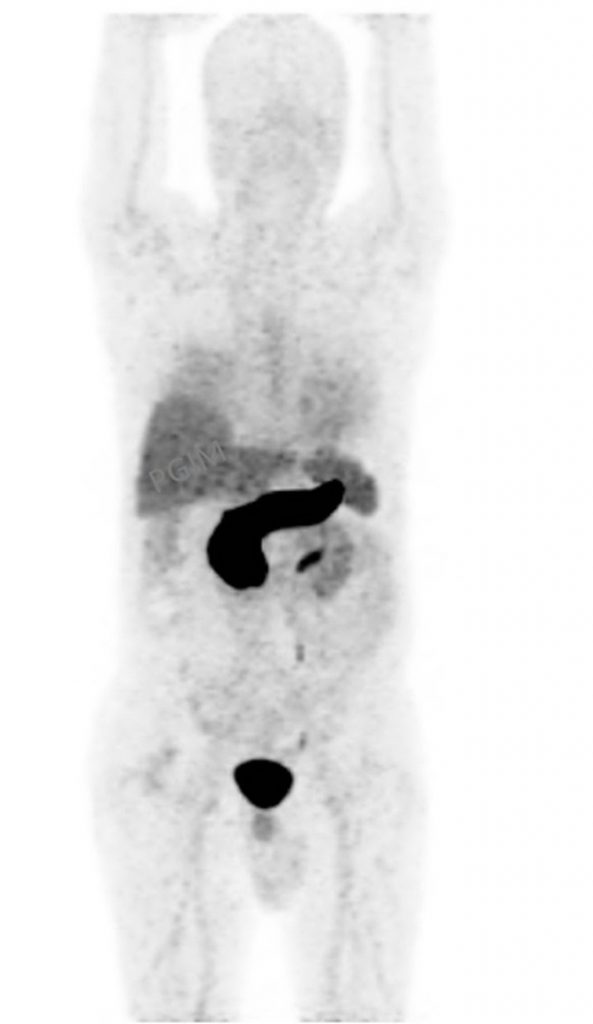PET Radiopharmaceuticals
Uploaded July 7th, 2020
By:
In the last decade, rapid advances have been made in the field of PET radiochemistry with development of novel tracers targeting different cellular pathways. Each radiopharmaceutical has its unique physiological distribution.
Identify the PET radiopharmaceutical in the following Maximal Intensity Projection image?
- A) 18F-Fluciclovine
- B) 68Ga-Exendin
- C) 68Ga-RM2
- D) 68Ga-RGD
Scroll down for answer

Answer: 68Ga-RM2
Discussion
68Ga-RM2 PET
68Ga-RM2 [68Ga-labeled DOTA-4-amino-1-carboxymethyl-piperidine-D-Phe-Gln-Trp-Ala-Val-Gly-His-Sta-Leu-NH2] is a synthetic bombesin receptor antagonist that targets the gastrin releasing peptide receptor. Gastrin releasing peptide receptors are highly expressed in several human tumors including prostate cancer. Gastrin releasing peptide receptor are expressed in 63% to 100% patients of prostate Ca. 68Ga-RM2 has the highest physiologic uptake in the pancreas followed by moderate uptake of the tracer in the liver, spleen and urinary excretion. It has garnered interest as a target for prostate theranostics, especially due to lack of salivary gland uptake which is prominently seen in 68Ga-PSMA PET. A recent study examined the use of [68Ga]RM2- PET/CT (GRPR antagonist) in patients with known biochemical recurrence of prostate cancer and negative or equivocal [18F] fluoroethylcholine-PET/CT and demonstrated that [68Ga] RM2-PET/CT was helpful in localizing the recurrence in such cases (1-2).
18F-Fluciclovine
Fluciclovine is the synthetic alicyclic amino acid analog of l-leucine, which targets LAT1 and ACST2 transmembrane amino acid transporters, both of which are over expressed in prostate cancer cell. The highest physiologic tracer uptake is seen in the pancreas (lower intensity to 68Ga-RM2). However, this uptake decreases within 15 minutes after injection of the radiopharmaceutical such that the avidity of the pancreas decreases to a level lower than that of the liver. The liver has the second highest physiologic activity. There is moderate salivary gland and pituitary gland uptake and variable mild to moderate bowel activity. An advantage of 18FFluciclovine is its excretion into the urine is very little, which leads to less interference and improved evaluation of potential recurrent disease in the pelvis. Two tissue types demonstrate dynamic uptake, which changes during the course of the scanning examination: Red marrow activity peaks at a moderate intensity 10–15 minutes after the injection and decreases over time.
Conversely, muscle uptake is mild during the early phases of the examination and increases over time (3).
68Ga-Exendin PET
Glucagon-like peptide-1 receptors (GLP-1R) are highly overexpressed in insulinomas and glucagonomas. 68Ga-NOTA-exendin-4 PET/CT targets GLP-1 receptors for the identification of occult insulinoma. On 68Ga-Exendin PET, intense physiological distribution in the kidneys and bladder due to urinary excretion, moderately elevated uptake is apparent in the proximal duodenum and mild uptake is seen in pancreas at 1 h after injection of 68Ga-NOTA-exendin-4 (4).
68Ga-RGD PET
αvβ3 integrins play an important role in angiogenesis and cell migration in cancer and are highly expressed on the activated endothelial cells of newly formed blood vessels. 68Ga-labeled cyclic arginine-glycine-aspartate (RGD) PET targets αvβ3 integrin–expressing tumor neovasculature.
Used for angiogenesis imaging, 68Ga-NODAGA-RGD images demonstrated significantly higher uptake in the spleen and kidneys compared to 18F-FDG, while the uptake is lower in the brain, the parotid glands, the mediastinum, the myocardium, the lung, the liver, the psoas muscle, and the bone. Significant tracer uptake is not seen in pancreas (5).
References
- Baratto L, Duan H, Laudicella R, et al. Physiological 68Ga-RM2 uptake in patients with biochemically recurrent prostate cancer: an atlas of semi-quantitative measurements. Eur J Nucl Med Mol Imaging. 2020;47(1):115-122. doi:10.1007/s00259-019-04503-4.
- Wieser G, Popp I, Christian Rischke H, et al. Diagnosis of recurrent prostate cancer with PET/CT imaging using the gastrin-releasing peptide receptor antagonist 68Ga-RM2: Preliminary results in patients with negative or inconclusive [18F]Fluoroethylcholine-PET/CT. Eur J Nucl Med Mol Imaging. 2017;44(9):1463-1472. doi:10.1007/s00259-017-3702-8.
- Gusman M, Aminsharifi JA, Peacock JG, Anderson SB, Clemenshaw MN, Banks KP. Review of 18F-Fluciclovine PET for Detection of Recurrent Prostate Cancer. RadioGraphics 2019;39(3):822-41.
- Luo Y, Yu M, Pan Q, et al. 68Ga-NOTA-exendin-4 PET/CT in detection of occult insulinoma and evaluation of physiological uptake. Eur J Nucl Med Mol Imaging. 2015;42:531-532.
- Durante, S., Dunet, V., Gorostidi, F. et al. Head and neck tumors angiogenesis imaging with 68Ga-NODAGA-RGD in comparison to 18F-FDG PET/CT: a pilot study. EJNMMI Res 10, 47 (2020). https://doi.org/10.1186/s13550-020-00638-w
